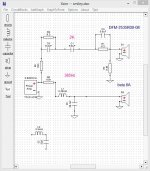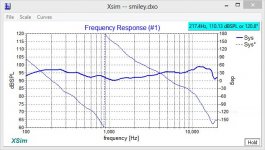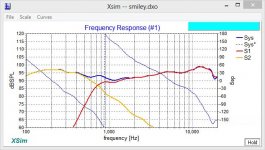Hi,
Doing the search on "smiley" curve passive X-over and could not find info about it. How do I proceed? This is 2ways with CD + horn combination and woofer for home music, karaoke. It's seem easy on my ear and less fatigue. Did I get it wrong just wondering! Thanks,
Doing the search on "smiley" curve passive X-over and could not find info about it. How do I proceed? This is 2ways with CD + horn combination and woofer for home music, karaoke. It's seem easy on my ear and less fatigue. Did I get it wrong just wondering! Thanks,
A "smiley" curve is easy to achieve by turning down the midrange and boosting low and high end on tone controls or an equalizer.
To effectively do the same in a 2 way passive crossover requires many times the amount of parts used in a normal crossover, and "throws away" the mid-range power wasted in resistors.
It is not practical, and is seldom done.
One can get a "hole in the middle" response with the same amount of parts as a normal passive crossover without wasting power by leaving a gap between the crossover points, for instance rather than both the woofer/tweeter crossing at 3000Hz, the woofer could be crossed at 1500Hz, the tweeter at 6000Hz- built in "smiley curve".
To effectively do the same in a 2 way passive crossover requires many times the amount of parts used in a normal crossover, and "throws away" the mid-range power wasted in resistors.
It is not practical, and is seldom done.
One can get a "hole in the middle" response with the same amount of parts as a normal passive crossover without wasting power by leaving a gap between the crossover points, for instance rather than both the woofer/tweeter crossing at 3000Hz, the woofer could be crossed at 1500Hz, the tweeter at 6000Hz- built in "smiley curve".
Last edited:
Is it possible to make an increasing order crossover with a few edges? Like for LPF 3dB/oct from 500-1000, 6dB 1000-2000, 12dB 2000-4000 and then 18 etc? And of course similar opposite for HPF. That would allow you both play around with smiling curve and driver protection combined. If not I think a first order crossover pulled a few octaves away from the actual crossover point will give that smiling curve as indicated in your post above but I’m conserned that the LF cone breaks ups will come out anyway as well as the HF power handling may be limited. What’s your drivers size OP? Warmth can also be achieved just my lowering HF with an lpad or crossing higher as the horn might have limited extension?
Last edited:
Is it possible to make an increasing order crossover with a few edges? Like for LPF 3dB/oct from 500-1000, 6dB 1000-2000, 12dB 2000-4000 and then 18 etc?
A non-standard rolloff of 3dB/octave (half order) that you mention is in fact more complicated to obtain when compared to a first order (6dB/octave) one. Cinemas use this type of equalisation (X-curve) to balance the direct and reverberant sound fields, and as we all know, they achieve it electronically.
This is a half-order lowpass filter, for the sake of comparing the number of components.
Last edited:
For karaoke I find upper mids and highs down works best. Highs being the most important. Maybe it's just me lol
Is it possible to make an increasing order crossover with a few edges? Like for LPF 3dB/oct from 500-1000, 6dB 1000-2000, 12dB 2000-4000 and then 18 etc? And of course similar opposite for HPF.
This is called a transitional filter and it may offer some advantages regarding group-delay if someone knows what he is doing. But I wouldn't use it for a smiley face response.
As others have mentioned the desired target curve is best achieved by the use of equalising before the amp because of the efficiency advantage.
Regards
Charles
Art, It's definitely not practical. It's always better with the mid tone control turn down a tad. I want to experiment if it's doable as long as it's put out decent volume and not to blow up anything. I might end up build one just to try. I appreciated everyone advices.
I just simulate with factory data. What do you think?
I just simulate with factory data. What do you think?
Attachments
1hiep0,
I think creating a depressed midrange response on a loudspeaker when equalization is available limits ones choices.
I think throwing away power by using a series resistor on a woofer is a bad idea.
Art
I think creating a depressed midrange response on a loudspeaker when equalization is available limits ones choices.
I think throwing away power by using a series resistor on a woofer is a bad idea.
Art
Conceivably you could create a wide smiley curve (more like a smirk) by misaligning a ported box ie too small in volume, tuned a bit too high which creates a hump in the bass response and over-compensating the cd horn eq.
- Home
- Loudspeakers
- Multi-Way
- "smiley" EQ curve


